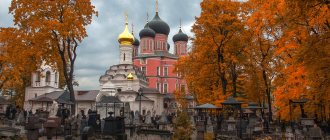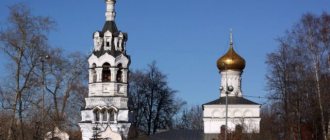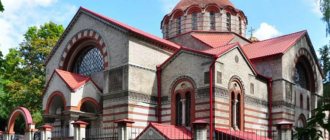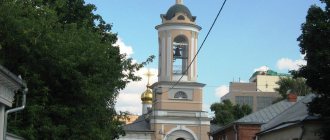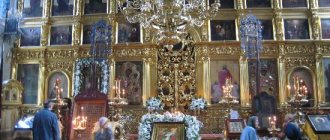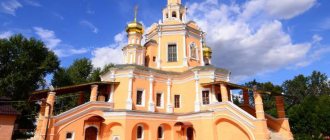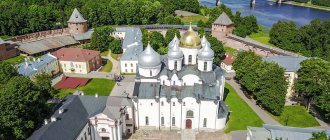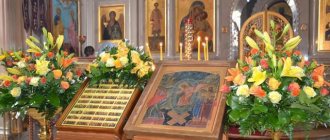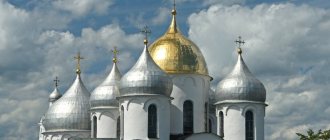The Temple of the Sign on Rizhskaya is a magnificent building that is not only of enormous cultural value, but is also an amazing architectural monument of Moscow. The Church of the Sign on Rizhskaya, unlike many other church institutions, was always open to parishioners. It survived the invasion of Napoleon in 1812, survived the atheistic persecution of the Soviet regime, and was preserved by the mercy of God during the shelling of Moscow in 1941. The Riga overpass posed a danger to the temple. But the Most Pure Mother of God, by the power of Divine prayer, averted trouble from Her home.
The Church of the Mother of God of the Sign is a wonderful place where the soul calms down, where you can pray and talk directly with God. And the splendor of the temple decoration surrounding you will help you tune in to the right mood and, at least for a while, forget about the bustle of the world.
History of the appearance of the temple
In the 16th century, in the Pereyaslavskaya Sloboda there was a small wooden church, named in honor of the Beheading of John the Baptist . But the fire completely destroyed the church. A year later, in 1713, a new church, called “The Signs of the Most Pure Mother of God,” already stood in its place.
44 years passed and, with donations from Orthodox citizens, the construction of a stone church building began. In 1765, the Church of the Sign of the Most Pure Mother of God was consecrated. At the end of the 19th century, the temple underwent reconstruction - new boundaries and a passage between the bell tower and choir were added to it. It still stands in this form.
The temple was originally built in the Baroque style; later reconstructions were carried out in the same style and therefore the impression of a single completed structure is created. In the Temple of the Sign there are 4 thrones, each of which has its own revered image:
- the central altar is the Most Pure Mother of God “The Sign”;
- southern throne - “Beheading of John the Baptist”;
- northern throne - St. Nicholas;
- side altar – St. Martyr Tryphon.
The last of the thrones was presented to the temple as a gift by the skilled woodworker V.I. Kudinov (1980). The throne was made of giant oak, which was 250 years old.
The outside walls of the temple building are painted red and finished with white paint. The combination of these colors gives the temple a solemn and festive look. The interior decoration of the Church of the Sign amazes with its highly artistic taste.
The interiors are decorated in warm pastel colors; there is nothing bright or flashy. Everything is in moderation, it is felt that the design work was carried out with great love.
Patronal holidays
The following holidays are revered and celebrated in the temple:
- December 10 is the day of the Znamenskaya Icon of the Blessed Virgin Mary;
- September 11 - Beheading of John the Baptist;
- December 19, May 22 and August 11 are the days of remembrance of St. Nicholas the Wonderworker;
- February 14 - memory of the holy martyr Tryphon;
- September 27 - Exaltation of the Life-giving Cross of the Lord;
- December 4 is the memory of the holy martyr Alexander Khotovitsky.
Read about other Orthodox holidays:
- Holy Apostles Peter and Paul
- Protection of the Blessed Virgin Mary
- Circumcision of the Lord
Shrines of the Temple of the Sign
During Soviet atheism, many churches in Moscow were closed and destroyed. The Znamensky Church was active at that time, and shrines from damaged churches were brought there. Nowadays, under the temple vaults of the Sign, the capital's volumes of the Christian faith are collected.
Icon with the relics of Saint Tryphon
Icon of the Mother of God in the Znmensky Church
Particularly revered temple icons and symbols of Orthodoxy:
- The image “The Sign ” is the main temple face , copied from a 16th century icon (Novgorod). The Mother of God is depicted with her hands raised in prayer, with the Divine Child depicted on her chest.
- The image of John the Baptist is a 17th century icon; in 2000, it was miraculously renewed in front of the parishioners.
- Image of St. much Tryphon - icon from the Church of St. Tryphon (1931). The image depicts particles of the relics of St. much Tryphon.
- The image of the wonderworker Seraphim of Sarov - the icon was handed over by the sisters of the Diveyevo metochion after its closure in 1927. Along with the icon in the temple there are also parts of the coffin of St. Seraphim.
- The Honest and Life-Giving Cross of the Lord - a crucifix from the Passionate Monastery ( 30s of the 20th century).
- The miraculous Krestovsky Cross - the shrine dates back to 1652, appeared in the temple in 1929. Initially, the Cross stood in the chapel at the Krestovskaya outpost. The chapel was destroyed.
Abbots
- Vasily Flerin (1906 - March 31, 1908)
- Gabriel Kossin (1908 - 1915)
- Sergius Glagolevsky (1916 - 1917) [1]
- Leonid Bagretsov (1923 - ?)
- sschmch. Ioann Smirnov (December 30, 1935 - November 22, 1937)
- Stefan Markov (1937 - February 28, 1954)
- Alexander Derzhavin, acting during the illness of Fr. Stephen, then honorary rector [2]
…
…
How to get to the temple
The Temple of the Sign on Rizhskaya is located at the address: 2nd Krestovsky lane, 17, p. 1.
You can get to it using the metro - the nearest station is Rizhskaya, you only have to walk for a couple of minutes. You can get there by bus, routes 239, 84, T25, stops are located near the temple. Nearby, within a few minutes' walk, is the Rzhevskaya railway platform, where electric trains from Belarus, Kursk and Riga stop. This type of transport, if convenient, can also be used.
Architecture
Sergei Solovyov is one of the most talented architects of the late nineteenth century. The Church of the Icon of the Mother of God in Kuntsevo combines various architectural trends. The building is a five-pillar church with one prominent dome.
Thus, the master embodied the idea of an equilateral volumetric Greek cross. The external appearance is dominated by the Ravenna style, while the internal appearance reflects Byzantine traditions. While in the Church of the Sign, it’s easy to imagine yourself in the ancient temple of Constantinople. The effect was achieved not only through stylized details, but also through a subtle calculation of the proportions of the interior.
Schedule of services
Liturgy in the Znamensky Church is served daily. On weekdays once, at 8 o'clock in the morning. On Sundays and holidays the service is held twice, at 7 o'clock and 10 o'clock in the morning. The evening service begins at 17:00 in winter, and at 18:00 in summer.
Every day at the end of the liturgy a prayer service is served with an akathist to St. much Tryphon. After the Sunday evening service there is a prayer service with the blessing of water and the reading of the akathist the Sign of the Most Pure Theotokos. You can also order a memorial service for the deceased. It is held after the liturgy.
Photos
The Temple of the Icon of the Mother of God of the Sign in Kuntsevo is a significant architectural monument of the early twentieth century. Photos of the church can be found in the biography of the architect Sergei Solovyov, in guides to Moscow, in architectural and historical magazines, as well as in blogs of those interested in the capital’s history.
Current state[edit]
Description[edit]
The temple is single-domed, square, with an upper tier and a dome. In the eastern part of the refectory (on the second floor) there are choirs. The bell tower is quadrangular, three-tiered.
Temples[edit]
Interior decoration of the temple
- In 1980, an additional altar was consecrated in honor of the holy martyr Tryphon
. The consecration was performed by a small priestly rite. - The parish has a Baptismal Church in honor of the Hieromartyr Alexander Khotovitsky
. The temple was built in 1998. Architect V.S. Vasiliev.
On December 10, 1999, His Holiness Patriarch Alexy II performed the great consecration of the temple.
- Church of the Exaltation of the Holy Cross at Krestovskaya Zastava
.
On June 9, 1652, Moscow solemnly greeted the honorable relics of the holy martyr. The procession with holy relics walked along the street, which is now called Prospekt Mira, but as soon as they crossed the Kaplya River, it was forced to stop on the occasion of the sudden death of Metropolitan Varlaam.
In memory of these events, an oak cross was built. At the meeting place of the relics of St. Philip, a special chapel was built for the Cross. Numerous pilgrims prayed in it as they walked along the Trinity Road to the Lavra of St. Sergius. Crowned pilgrims - Russian sovereigns - also stopped near the chapel. Here they listened to a prayer service and changed into traveling clothes.
The chapel was destroyed in 1929, and the Cross was brought to the Church of the Holy Trinity “on Drops”, and after its closure - to the Znamensky Church, where it was kept in the altar of the Baptist chapel.
In 1997, through the efforts of the church council, the temple territory was enlarged and it became possible to recreate the Krestovskaya chapel, so that the Cross located in the altar of the temple would become available for worship by believers, and so that the Krestovskaya chapel would stand at the Krestovskaya outpost, as before. With the blessing of the late His Holiness Patriarch Alexy II, it was decided to build not just a chapel, but a temple in honor of the Exaltation of the Holy Cross.
Major construction work was completed by the end of 2008. An image of the Holy Trinity appeared on the western wall of the temple - a tribute to the memory of the ancient Trinity outpost.
Sunday school[edit]
There is a Sunday school at the church.
Social activities[edit]
The parish provides assistance to disabled people, orphans, disabled children, homeless people, and the infirm. The head of the mercy group is priest Dimitry Privezentsev, telephone:
8-965-122-96-55.
Shrines[edit]
Icon of the Mother of God “The Sign”
- temple icon “The Sign” (17th century copy from the Novgorod original)
- wooden cross-crucifix (XVIII century) from the destroyed Strastnoy Monastery;
- icon of the martyr Tryphon with a piece of his holy relics
- icon of John the Baptist (XVIII century)
- icon of St. Macarius of Kalyazin
- icon of St. Nicholas the Wonderworker (XVIII century)
- icon of Saints Adrian and Natalia (from the closed church of Saints Adrian and Natalia in Meshchanskaya Sloboda)
- Iveron Icon of the Virgin Mary
- icon of St. Theodosius of Chernigov with a piece of his vestment
- icon of Joasaph of Belgorod
- Ozeryansk Icon of the Mother of God
- icon of Saint Philaret the Merciful
- icon of St. Sergius of Radonezh
- icon of St. Seraphim of Sarov
- Icon of the Holy Equal-to-the-Apostles Grand Duchess Olga
- image of the Mother of God and the holy Apostle John the Theologian standing at the Cross of the Lord
